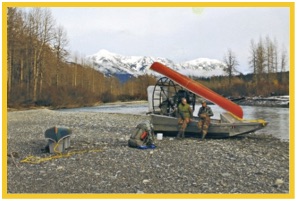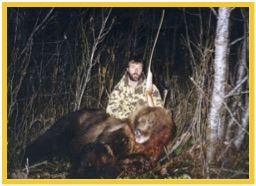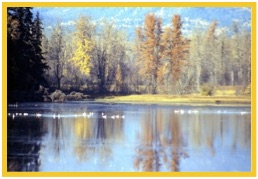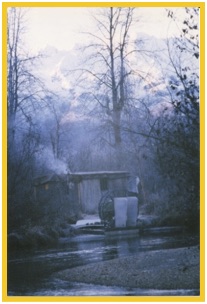 In August 1999, preparations for guiding my first brown bear hunt of the fall season required two days of clearing logjams with a chainsaw, enabling airboat access to my most remote hunting location. Days later, I returned to clean and rake my paths, leading to the chum salmon spawning beds that always attract bears. Then I mounted two tree stands overlooking a convergence of game trails and stream features idyllic for archery hunting. On the return downriver, I inspected my two emergency camps maintained along the way.
In August 1999, preparations for guiding my first brown bear hunt of the fall season required two days of clearing logjams with a chainsaw, enabling airboat access to my most remote hunting location. Days later, I returned to clean and rake my paths, leading to the chum salmon spawning beds that always attract bears. Then I mounted two tree stands overlooking a convergence of game trails and stream features idyllic for archery hunting. On the return downriver, I inspected my two emergency camps maintained along the way.
 When compound-bow-hunter Dawson Colby of Michigan arrived in mid-September, we loaded our gear into my high-performance airboat with a critical eye before powering up the perilous river. I had designed and then armored my airboat to meet the rigors of the challenge, then only guided a select few to their rifle and archery hunts at this game-rich location I call “The Zoo.” No one else had successfully run their boat within miles of our destination. The wreckage eroding from the gravel bars chronicled those who tried.
When compound-bow-hunter Dawson Colby of Michigan arrived in mid-September, we loaded our gear into my high-performance airboat with a critical eye before powering up the perilous river. I had designed and then armored my airboat to meet the rigors of the challenge, then only guided a select few to their rifle and archery hunts at this game-rich location I call “The Zoo.” No one else had successfully run their boat within miles of our destination. The wreckage eroding from the gravel bars chronicled those who tried.
Dawson behaved sensibly, and I knew him to be athletic and an exceptional hunter. Still, responsibility prompted weighing glances at my charge. Dawson reflected a well-prepared middle-aged man heading into the unknown for his long-anticipated brown bear hunt. En route, the headwind from our progress blew his long, white beard side to side while he studied the glacier-clad mountains and old-growth forest we passed through. Further along, Dawson broadly grinned while leaning into the three sets of steep, boulder-strewn rapids we navigated. Then he flashed a smile each time the airboat jumped newly fallen trees and drift logs spanning the swift channels.
I always kept a canoe hanging in a tree where we camped, making no fire, across the river from the tree stands to distance us from the hunting area. After paddling our canoe across the main river, we quietly walked my groomed trails leading to the side-stream spawning beds, where bear-sign abounded.
On the first day, the sunlit flanks of the twenty-mile-long Takhin Ridge presented a panorama of peaks and alpine meadows. Solitary bears and others with cubs grazed near bands of mountain goats, fading into the blue distance.
From the vantage of our tree stands, we viewed a dozen or more wolves catching salmon and filtering through the alder-choked creek bottom while others howled from the surrounding forest. The next day, a young wolf presented a standing, broadside shot at 35 yards. I knew Dawson had it cold. When his arrow struck, the wolf gave a single yelp, then it bit the carbon-fiber shaft in half and died as the stream ran red with blood. We remained silent in our tree stands. Within the hour, another wolf traced the blood carried in the stream. It cautiously stalked directly to the submerged dead wolf, then sniffed the single tuft of fur breaching the surface. When Dawson struck again, the second wolf died atop the first one.
Over the next two nights, wailing wolves closely surrounded our tent. I refrained from firing my handgun to drive them away, knowing it would also displace bears. However, we hunted for days without spotting a single bear fishing for salmon while howling wolves proclaimed their ownership of the spawning beds. Over the years, I had routinely studied wolves while they fished among bears at the Zoo; the recent, sizable invasion of those territorial predators had driven the bears away. Conceding defeat, we broke camp amid a chorus of wolves hurling insults until the roar of my departing airboat silenced their taunts.
Dawson had not yet left when traditional-archer Don Ferraro arrived at base camp to begin his brown bear hunt. Don’s home-remodeling business in New Jersey had prospered after Hurricane Floyd had recently savaged their coastal region. He wished to only hunt briefly before leaving to oversee new employees.
 Because Dawson did not see any bears at the Zoo, I suggested he remain at our bunkhouse as a guest until Don had completed his abbreviated hunt; then, Dawson could continue in his place.
Because Dawson did not see any bears at the Zoo, I suggested he remain at our bunkhouse as a guest until Don had completed his abbreviated hunt; then, Dawson could continue in his place.
Don Ferraro’s hunt would occur in the same drainage where a bear had tragically mauled my elderly acquaintance, Forest Young, in 1955. I told Don the gruesome story, underscoring the risk of hunting brown bears with a bow on the ground as he intended. We hoped for a shooting opportunity at less than 20 yards, as afforded Rex Dacus when hunting the same location with me two years previously. While ground-hunting with his longbow, Rex drove a wooden arrow through the heart of a mature brownie at 15 yards.
 I ran my airboat up the glacier-fed Chilkat river to the cabin-based hunting area. While gliding up the smooth river, the surrounding forest displayed a mosaic of burgeoning fall colors; then, we navigated a small, brushy stream where the fully loaded airboat powered across dry channels.
I ran my airboat up the glacier-fed Chilkat river to the cabin-based hunting area. While gliding up the smooth river, the surrounding forest displayed a mosaic of burgeoning fall colors; then, we navigated a small, brushy stream where the fully loaded airboat powered across dry channels.
As I stowed gear inside the cabin, Don saw three brown bears pass nearby. When we investigated their footprints, I commented that all the tracks were about the same size and that the bears were not large enough to interest us. Referring to them as “The Rat Pack,” I mentioned that three adolescent bears running together, or a sow with two large cubs remaining through adolescence, was potential trouble.
 We hiked up the clear stream the next day, where fresh bear activity flourished amidst spawning coho salmon. Don had his Black Widow recurved bow; I carried a favored Winchester Model 70 .458 magnum rifle containing my 400-grain handloads.
We hiked up the clear stream the next day, where fresh bear activity flourished amidst spawning coho salmon. Don had his Black Widow recurved bow; I carried a favored Winchester Model 70 .458 magnum rifle containing my 400-grain handloads.
While we walked exposed to view, an 8-foot male brown bear briskly strode our way. I quickly kneeled; Don hunkered behind, nocking an arrow. The bear avoided eye-to-eye contact as it rapidly approached within archery range. Boldly ignoring our presence, the bear chased salmon without presenting the broadside shot that Don needed; then, it caught a fish and walked directly away. When reaching the nearby brush line, it stopped, turned, and brazenly stared at us with the struggling coho in its mouth, proclaiming, “I know you’re there! But I’m big and tough, and I got mine, so I don’t care!”
We fashioned an ambush blind near the end of a brushy point projecting into the shallow, winding side channel where the brownie had been fishing. I cut three shooting lanes to the water’s nearby edge.
Back at the cabin that evening, Don said, “Seeing those three bears as soon as we arrived and then having that big boar walk right up to us this morning is more than I ever expected! I hardly need to shoot a bear now, and I already got my money’s worth anyway. It’s no matter that I’m leaving early!”
The following morning, we returned to the blind. Positioning my folding chair, a whisper behind and offset from Don’s chair, provided me a proper sight radius while reducing chaos if an attacking bear forced him backward.
Mounds of dry ferns would keep our chair seats comfortable and our feet off the cold ground. A trimmed, forked branch pushed into the soil propped my rifle, keeping it clean and in reach of my right hand while seated. A slender stick would prompt Don’s attention from behind and function as a pointer with little noticeable movement. We positioned our opened packs for convenient, quiet access and then reviewed the hand and touch signals used to judge any bear we might see. Settled with a downstream breeze, Don nocked an arrow and rested the bow across his lap.
Mid-morning, the boar we saw the previous day stepped into view just below, but it quickly caught our scent and retreated before Don saw it. Soon, we heard squalling and fierce growling further upstream. “It sounds like the Rat Pack is fighting among themselves,” I whispered. “If coming our way, they’ll likely be trouble. We want nothing to do with them.”
The quarreling bears exploded into view. Aligned three abreast, they charged in our direction, heads held high, sweeping their gaze side-to-side in unison while bellowing ferociously.
“Should I take one?” Don excitedly whispered. “No, I said. It’s the Rat Pack. There are too many for a bowhunter; too small, anyway. Let them run past. Then they should catch our scent and leave.”
Don shifted around while watching the oncoming bears. Slipping from my chair to kneel beside him, I gripped his shoulder while firmly but quietly instructing, “Freeze!” Don moved again. Tightening my grip, I stressed, “Don’t move a muscle; your life might depend on it.”
The ominous bellowing and overlapping thuds of twelve pounding feet grew louder, and my heartbeat grew stronger; one hand gripping Don’s shoulder, the other on my rifle. As the bears sped along the opposite streamside, 22 yards away, it appeared they would pass harmlessly. Then a coho salmon spooked through the shallows to our side of the stream. In pursuit of that lone fish, all three bears suddenly angled off course to launch into synchronized long jumps, landing in the shallow stream within spitting distance of us. It happened so quickly that I had no opportunity to react.
We watched the uproar of three agitated brown bears, breathlessly hopeful that one would catch the coho they fought over and then all leave without detecting us. Teeth violently snapped while forceful breathing supported guttural grunts and insanely coarse growls as their big feet splashed the water high into the air and onto us.
Suddenly, all three bears froze in the same instant, staring at us, then reacted before the water stopped falling. A sow remained stationary five yards to the front. Another sow disappeared to our right while a stout young boar circled to the left, into belly-deep water, from where it closed with jaws popping. “Stay seated!” I yelled, jumping in front of Don and taking two steps to his left. Challenging the oncoming boar from the slightly elevated stream bank stopped its advance, where it glared at me from a few feet away.
I held the rifle alongside my right hip, the muzzle trained on the boar, safety off, finger on the trigger. I matched its gaze while keeping the sow, standing to the right, in my corner vision, yet mindful that the third bear now lurked behind. My mind raced to find means for us to survive three attacking bears, short of killing any. Holding my fire from the high ground might unnerve the young boar, possibly ending the confrontation. Then it quickly surged through the water, decisively planting both front feet on the edge of the three-foot-high, vertical streambank where I stood. Remaining in place, it raised its head and shoulders while looking hard into my eyes.
With the rifle’s muzzle held mere inches from the bears chest, my confidence soared; yet, knowing I could not step back into Don’s seated position would force my only option if the bear pressed its attack. It suddenly broke our eye contact to glance behind me, indicating the third bear was in view; then, it started heaving up the bank.
Pulling the rifle barrel from the reach of the bear’s jaws, I fired from my hip, center to its chest. I saw the bullet-shock shimmy through the bear and then ripple across the water as the formidable concussion rebounded off the broad chest, smacking my face the instant the bear dropped dead.
Sparing the sow still to my right, I reloaded while turning and bounding past Don again, positioning between him and the sow I knew advanced from behind. She stalked along the shooting lane leading to Don’s right side, her head carried low. When confronted, the sow paused to stare up into my eyes. The rifle ready at my hip, I quietly pleaded, “Don’t do it; don’t do it.” She raised her head, searched behind me, then closed so fast that I instinctively leaped highly backward. The rifle’s barrel projected under her nose while firing downward; I saw the impact quake through the bear when the 400-grain bullet drove it to the ground before landing astride its snout.
The last bear remained stationary while casting glances to where the others fell from view when the big rifle twice roared. Its demeanor projected confusion and uncertainty, implying that it no longer presented a significant threat. I charged at the bear, and then it began running away. But as soon as I stopped, it also stopped. Then I ran at it while shouting wildly. The bear stood its ground for a long moment before running off as I pursued until it disappeared into the alder jungle.
Still sitting in his chair, Don touched the dead boar’s nose with an arrow held in his extended left hand while the sow laid four arrow lengths to his right. Yet, Don seemed wholly composed when remarking, “I didn’t think this hunt could get more exciting than yesterday.” He had performed bravely and flawlessly, trusting my judgment and ability by remaining seated without a firearm.
Examining the teeth of both dead bears revealed that the sow was older than the boar, yet both were the same size. After thinking through our encounter, I proposed, “It appears that we were dealing with a mature but young sow and two adolescents that had been her first cubs. They were agitated from fighting among themselves before we saw them. The fresh wounds on their faces demonstrate their antagonism toward each other. Typically, they would have gone their separate ways before now but found strength in running the spawning beds together while bellowing to frighten other bears away. They could then claim the salmon for themselves. When abruptly spotting us so close, they instinctively followed the same aggressive routine that had served them well. But the young boar took it to the next level. If I hadn’t shot it, the sow might not have attacked.”
I planned to use the carcasses for bear bait when hunting with Dawson. We drug both into the trees, skinned them, and then covered their remains with brush and debris to keep the eagles and ravens from quickly eating them.
As required, we willingly forfeited the hides and skulls to the State of Alaska, and detailed the incident in an official state “Defense of Life Report.”
Three days passed, then Dawson and I returned. Fresh tracks showed that a huge boar brownie had fed on both carcasses, then lightly concealed them with soil and ferns. Confident the boar would return, we swiftly fashioned another ground blind.
Late that evening, the young sow from my earlier encounter with Don cautiously approached the remains, nervously sniffing around the area. I discouraged Dawson from killing her, and he kindly respected my desire. Before long, she stared upstream and raised her nose into the breeze; then, she bolted in the opposite direction while casting hurried glances over her shoulders. The big bear had likely returned to feed, but moonless darkness overtook Dawson’s final day.
Dawson Colby left without killing a bear, as did Don Ferraro. Nonetheless, the stories of our most memorable hunting adventures are the trophies best shared with others.